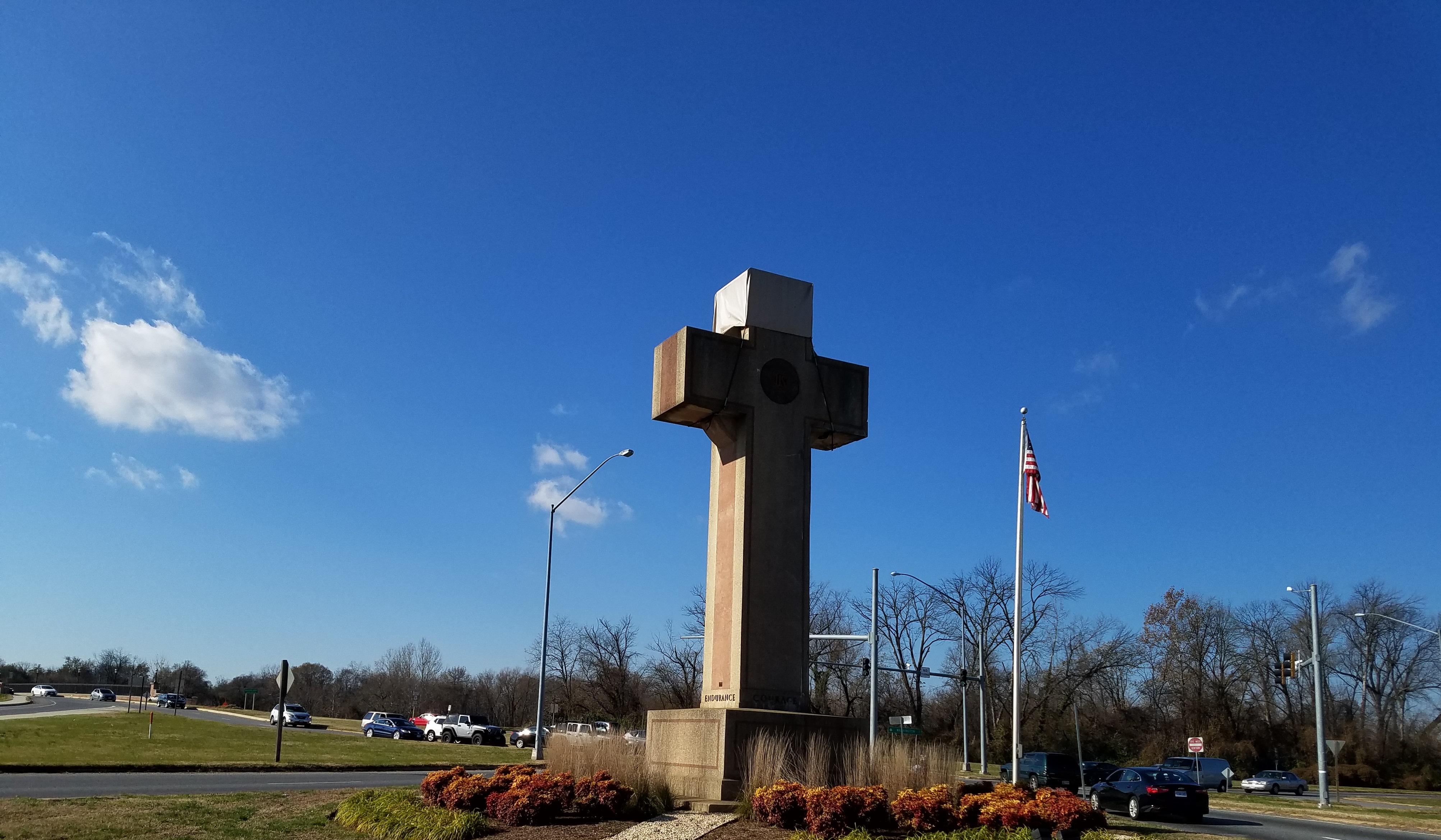A towering 40-foot-tall cross on public land in Bladensburg, Md., may stay where it is in part because it has taken on secular meaning over the years, the U.S. Supreme Court ruled June 20.
The structure, known as the Bladensburg Cross (or sometimes the “Peace Cross”), has stood in Prince George’s County, a northern suburb of Washington, D.C., since 1925. Originally erected by private groups to commemorate locals who died in World War I, it passed into government hands years ago. In the 1980s, it was rededicated as a memorial to all veterans who died in wars.

Critics pointed out, however, that a Latin cross, as the central symbol of Christianity, could not stand for all deceased veterans. The American Humanist Association (AHA), a national group of non-theists based in D.C., filed suit against the cross in 2015. The group won a ruling against government ownership and display of the cross from an appellate court, but the Supreme Court ruling has reversed that decision.
Americans United sharply criticized the high court’s 7-2 ruling in American Legion v. American Humanist Association.
“The Supreme Court’s misguided decision to allow government to play favorites and prominently display religious symbols as public war memorials dishonors our country’s veterans and the fundamental principle of religious freedom they fought and died for,” said Rachel Laser, president and CEO of Americans United. “The towering Bladensburg Cross is an inherently Christian symbol that excludes thousands of non-Christian veterans and ignores the tremendous sacrifices they made.
“Just because something is a tradition doesn’t make it right,” continued Laser. “In 2019, the court ought to know better than to permit the government to continue causing harm and violating our constitutional principles just because we’ve always done it that way.”
She concluded, “The Supreme Court’s decision elevates an outdated custom above the religious freedom that our Constitution guarantees to all Americans. We urge Maryland and all government officials to do better by their residents by ensuring that public land is inclusive for all, not just for some.”
The Supreme Court’s misguided decision to allow government to play favorites and prominently display religious symbols as public war memorials dishonors our country’s veterans and the fundamental principle of religious freedom they fought and died for. The towering Bladensburg Cross is an inherently Christian symbol that excludes thousands of non-Christian veterans and ignores the tremendous sacrifices they made.
~ AU’s Rachel Laser
Americans United led a group of 15 religious and civil rights organizations in filing a friend-of-the-court brief in the case. The organizations had urged the Supreme Court to affirm that the Bladensburg Cross is an unconstitutional religious symbol on public property.
The court’s decision means that the cross, which stands on a traffic island at the intersection of several busy highways, will remain in place. Writing for the majority, Justice Samuel A. Alito relied heavily on the fact that the cross is nearly 100 years old. In Alito’s view, the cross, despite its clear sectarian connotations, has taken on a secular meaning over time.
“With sufficient time, religiously expressive monuments, symbols, and practices can become embedded features of a community’s landscape and identity,” Alito wrote. “The community may come to value them without necessarily embracing their religious roots.”
Alito was joined by Chief Justice John G. Roberts and Justices Brett Kavanaugh, Stephen G. Breyer and Elena Kagan. Justices Clarence M. Thomas and Neil Gorsuch agreed with the result but wrote separately to explain their views.
Gorsuch argued that the case should never have reached the Supreme Court in the first place. In his view, the plaintiffs who brought the case, a group of local residents who saw the cross on a regular basis and considered its display by government to be inappropriate, should not have had “standing” – that is, the legal right to challenge it in court.
“This ‘offended observer’ theory of standing has no basis in law,” Gorsuch opined.
If adopted by the rest of the court, Gorsuch’s narrow view of standing could prevent a lot of people from having their day in court when it comes to certain church-state cases.
Thomas, as usual, took the most extreme position. He agreed with the majority’s conclusion but refused to endorse its legal reasoning. Thomas argued that the court should have used the case as a vehicle to toss out basically all modern church-state law and start over again.
Even more alarmingly, Thomas asserted that the section of the First Amendment barring “establishment” of religion does not apply to state governments – a view he has promoted in previous church-state cases. Under Thomas’s view, the church-state provisions of the First Amendment apply only to the federal government. This would effectively allow states to declare official religions.
(Most legal scholars sharply disagree with Thomas and argue that the 14th Amendment, adopted in 1868, makes the First Amendment and other portions of the Bill of Rights applicable to the states.)
Also writing separately, Kavanaugh expressed some sympathy for non-Christians who argue that the cross doesn’t represent them.
“I have great respect for the Jewish war veterans who in an amicus brief say that the cross on public land sends a message of exclusion,” Kavanaugh wrote. “I recognize their sense of distress and alienation. Moreover, I fully understand the deeply religious nature of the cross. It would demean both believers and nonbelievers to say that the cross is not religious, or not all that religious.”
Kavanaugh added, “All citizens are equally American, no matter what religion they are, or if they have no religion at all.” He suggested that cross opponents could seek other remedies, noting, “The Court’s ruling allows the State to maintain the cross on public land. The Court’s ruling does not require the State to maintain the cross on public land. The Maryland Legislature could enact new laws requiring removal of the cross or transfer of the land. The Maryland Governor or other state or local executive officers may have authority to do so under current Maryland law.”
Breyer and Kagan were also not fully persuaded to adopt every aspect of the majority’s decision. They asserted that the decision does not scrap decades of church-state jurisprudence or hand down a broad rule that all religious war memorials are now acceptable.
Writing for the two, Breyer asserted, “Nor do I understand the Court’s opinion today to adopt a ‘history and tradition test’ that would permit any newly constructed religious memorial on public land. The Court appropriately ‘looks to history for guidance,’ but it upholds the constitutionality of the Peace Cross only after considering its particular historical context and its long-held place in the community. A newer memorial, erected under different circumstances, would not necessarily be permissible under this approach.”
An exclusively Christian symbol, the Latin cross is not emblematic of any other faith. The principal symbol of Christianity around the world should not loom over public thoroughfares, suggesting official recognition of that religion’s paramountcy.
~ Justice Ruth Bader Ginsburg
Justices Ruth Bader Ginsburg and Sonia Sotomayor dissented. Their dissent, penned by Ginsburg, made the obvious point that the Latin cross is a symbol of the Christian faith and doesn’t represent non-Christians.
“An exclusively Christian symbol, the Latin cross is not emblematic of any other faith,” Ginsburg asserted. “The principal symbol of Christianity around the world should not loom over public thoroughfares, suggesting official recognition of that religion’s paramountcy.”
What happens now? The Bladensburg Cross will be staying where it is, and might even get a facelift. One of the great ironies of this case is that for all their talk about the importance of the cross to the community, local governments and Maryland officials have allowed the structure to fall into disrepair. The top of it is covered with a cap to keep water out, and the arms of the cross are braced by struts. Officials now have the opportunity to make repairs, if they are so inclined.
The ruling is likely to affect other legal disputes over government-owned religious symbols, and those that are deemed “historic” will probably survive. But just how old a cross has to be to qualify as historic remains unclear. Days after handing down the decision, the Supreme Court ordered a lower court to reconsider its ruling that a cross owned by the city of Pensacola, Fla., in a public park must be removed. The current cross, made of concrete, dates to 1969, but a previous version made of wood was erected in 1941. (Unlike the Bladensburg Cross, the cross in Pensacola was not erected as a war memorial.) On Aug. 8, the 3rd U.S. Circuit Court of Appeals, citing the Bladensburg Cross ruling, held that a depiction of a cross can remain on the official seal of Lehigh County, Pa., in the case Freedom From Religion Foundation v. County of Lehigh.
The ruling may also have applications beyond the issue of religious displays. Since 1971, the Supreme Court has used a legal formula called the Lemon test to determine whether a law violates church-state separation. Under the test, which grew out of the 1971 case Lemon v. Kurtzman, a law is seen as in violation if it lacks a secular legislative purpose, if its primary purpose is to advance or inhibit religion, or if it fosters excessive entanglement between church and state.
Parts of Alito’s opinion directly attack the Lemon test’s so-called “shortcomings,” and imply that it should no longer be used. Fortunately, these portions of Alito’s opinion received only four votes and are not a part of the majority opinion.
But while the court majority did not explicitly state that it was overturning the Lemon test, it also did not apply it, and most legal observers agree that the standard set by it has been greatly undermined.
Members of AU’s Legal Department have analyzed the Bladensburg Cross ruling and determined that it leaves many questions unanswered. There will definitely be more to this story.


